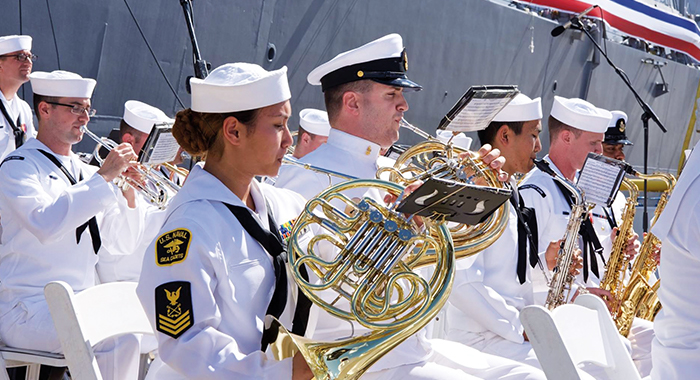Alumni Profile/Musician Finds His Place in the Band
It was the summer of 2000. Music education major David Baine ’01 was working checkpoint security at Austin Straubel International Airport, dreaming of the day he’d be in front of the classroom. Then a French horn came gliding through the baggage scanner.
The owner of the horn, a member of the U.S. Coast Guard Band, was heading Baine’s way. A French horn player himself, Baine was intrigued; he asked if the Coast Guard held auditions. The answer was yes – and, as a matter of fact, a French horn audition was coming up that fall.
Baine auditioned. He didn’t get it.
But, the whole experience got him thinking. What if this was a sign? What if he was supposed to play in a military band instead of teaching music?
Over the next several months, Baine auditioned for the Army, Navy and Air Force bands. Though still passionate about music education, in April 2001 he accepted a position with one of the Navy’s nine fleet bands stationed around the world. Three months later, Baine shipped out to boot camp.
Today, 19 years after that airport encounter with a French horn, Baine is chief musician in Navy Band Southwest, stationed in San Diego. As with the Navy’s other fleet bands, Navy Band Southwest performs at official functions, provides community and educational outreach, and is used to boost employee morale and retention.
“We’re storytellers,” Baine says. “We have a very important job making sure people realize what the Navy is doing. We’re also a diplomatic tool for the military.”
The fleet bands have a wide-ranging mission so no two days are alike. Each band supports anywhere from 300 to 500 performances per year, Baine says, many of which are in foreign countries as part of the Navy’s multinational outreach.
This demanding schedule surprises many, Baine says. In fact, the biggest misconception people have about military musicians is that theirs is a part-time occupation. “When people ask what I do in the Navy and I say I’m a musician, they’ll say, ‘But what do you really do?’”
While Baine’s job is often hectic, he loves it – especially the traveling, which has taken him to almost every state and nearly 50 countries, including Australia, South Africa and Russia.
“This has been an amazing experience,” Baine says. “It’s been beyond incredible. What better way to serve my country than doing what I love?”
Pinned
“Chief Musician (surface warfare)” is Baine’s official title. And it’s a rare one for a musician. The surface warfare parenthetical notation signifies Baine earned the Navy’s Enlisted Surface Warfare Specialist (ESWS) pin.
Most Navy personnel stationed on warships above the surface are required to earn this military badge, but musicians are exempt. But in 2009, when Baine was on board the USS Robert G. Bradley (FFG-49), he decided he wanted to earn the insignia anyway. And so he did.
“Becoming an Enlisted Surface or Aviation Warfare Specialist isn’t something that’s necessarily inherent to [everyone’s] job,” Master Chief Petty Officer Russ Smith says in a Navy Times article. “It’s just a sign they want to take their skill, knowledge and understanding to the next level.”
Oct. 31, 2019












